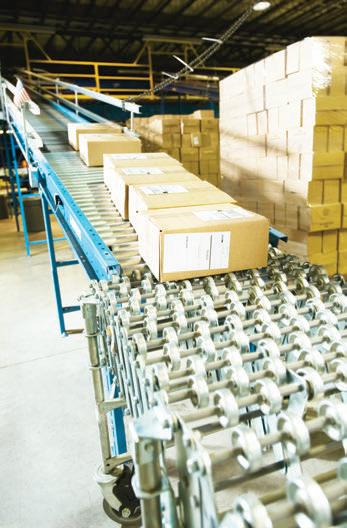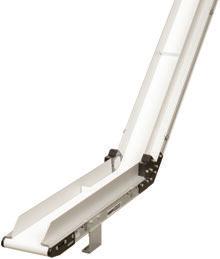
5 minute read
AUTOMATING PRODUCTION AND PACKAGING
from OEM Fall 2021
way back up to forestry, right on down to Kimberly-Clark, and then as seen by consumers in the retail setting in the toilet paper aisle. But I think going forward, it taught us a lesson, and we’re going to see more slack built into the system to be able to withstand these shocks and jolts to the supply chain. I think that the biggest lesson we see coming out of COVID-19 is just a preparedness that we may not have had before.
Riley: Do you see that beyond borders? Is that a reshoring of sourcing of materials? Is that having warehouses?
Reynolds: Yeah, it can be. I think it’s certainly the closing of the borders was a lesson to begin with, particularly China, which is such a massive supplier. India, secondarily. But I think just the reliance on single sources in a supply chain…that’s been disrupted in the sense that you no longer want to have all your eggs in one basket as the sole supplier of fiber, or the sole supplier of aluminum, or whatever it might be coming from one specific region. That’s a regional way of looking at it. But also from companies, different companies that are multinationals, you’re not going to be necessarily doing business with only one single company…what if their paper mill has an outbreak of whatever the pandemic du jour might be? Well then, does that shut you down? Or do you have an option B, option C?
So, it puts a lot more emphasis on supplier relationship management because if you want to be the one getting the packaging and materials you need, particularly in a scarcity environment, wouldn’t it pay to have a better relationship with your suppliers than your competitors have? Would it pay for you to adopt a position where you aren’t just beating up a key strategic supplier on price, but instead are actively engaged with those strategic suppliers and making a relationship aimed at both supplier and customer better? And not all suppliers, but certainly the ones that are the key strategic suppliers. Instead of chipping away at price, can you create a situation where you’re both prepared for shocks to the system, and you’re both diversified? And the supplier’s supplier, and the supplier’s, supplier’s, supplier’s, supplier. I think those are all lessons learned from the initial shock to the system. And I think that’ll all be implemented going forward.
Riley: Interesting. Using our example of the toilet paper, I went in the store, I couldn’t get it. So naturally, you go home, and you try to find it online, because now you’re picking from thousands of places. So clearly that had to be another shock to the supply chain, or another shock to the system. How did that play out?
Reynolds: It was a shock. I would call it an earthquake to the landscape of the omnichannel. So the omnichannel, the broadest way of thinking about it would be a three-legged stool, where you’ve got food service, educational, and industrial. It would be one of the legs. So, hospitality, food service, that sort of thing. Next would be retail, which we all know there was a run on retail. And then I think at least the temporary and probably long-term winner would be the ecommerce. And the rate of adoption of e-commerce accelerated. So, where we thought we would be in e-commerce in 2030, maybe we’ll be in 2025—in terms of adoption rates. Because people who had been resistant to it for whatever reason, not necessarily just that they’re troglodytes, but maybe they just don’t need it—they live in a neighborhood with everything they need within walking distance. Well, when those retail environments shut down, you turn to Amazon, you turn to e-commerce. But that had some negative ramifi cations, both in supply chain and also in their relationship to packaging, considering a retail environment or a food service environment. There’s a lot of packaging that’s happening in the back room, that secondary packaging, shrink wrap, corrugated, 50 pound bags of chicken that go to your local chicken fryer shop food service that are kept cloistered from the consumer. Well, with omnichannel a lot of that packaging ended up on people’s doorstep.
And what originally was a very strong sustainability movement prior to the pandemic, only accelerated it. It was a hockey stick type of “aha” moment. I just watched a commercial the other night, it was of the world’s strongest man breaking down your Amazon boxes. And basically, it brings into focus for consumers who had been happily, blissfully unaware, just how much packaging is involved in the supply chain. So, I think it’s a long trail of breadcrumbs to get there, but in a way COVID-19 has spurred sustainability in a way that it wouldn’t have had that acceleration curve prior to the pandemic.
Riley: How do we get from there to the next step? What is going to happen now?
Reynolds: I would say for the vast majority of food and personal care, CPG product brands, they’ve been struggling just to keep up, just to make sure product needs are met. Obviously, we know the trend of SKU proliferation. They squeezed the number of SKUs at a lot of these brands to concentrate on the highest volume items that they can just keep churning through nonstop. So, we saw a contraction in the number of SKUs in the industry over the last 16 months or so, that kind of coincided with the homespun feeling of looking for wholesome and nostalgic foods. Can imagine Campbell’s tomato soup probably had a good few quarters there.
TRANSFORMING CONVEYOR AUTOMATION
Simplify Conveyor Integration for Packaging & Processing Equipment Manufacturers
• Dorner Conveyors are built consistently and backed by rigorous quality control processes • Industry-best lead times ensure on-time execution of your projects • Conveyors fit into tight spaces and existing production environments • D-Tools, Dorner’s online configurator, allows you to build conveyors and access drawings and pricing











